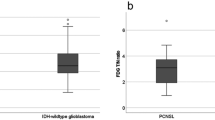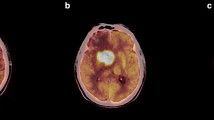Abstract
Purpose
2-deoxy-2-[18F]fluoro-d-glucose (FDG) positron emission tomography (PET) has been used as a promising tool to diagnose primary central nervous system (CNS) lymphoma because the tumor shows very high FDG accumulation. Although 11C-methionine (MET) PET has been reported to be useful for evaluating various brain tumors, the role of MET PET in CNS lymphoma is unclear. We compared the uptake of MET and FDG in patients with CNS lymphoma.
Procedures
Thirteen immunocompetent patients with CNS lymphoma were examined. All patients underwent PET with MET (15 min p.i.) and FDG (60 min p.i.). PET results were evaluated by visual and semi-quantitative analysis. For semi-quantitative analysis, the standardized uptake value (SUV) and tumor to contralateral normal brain tissue (T/N) ratio were determined by region-of-interest analysis.
Results
For detection of CNS lymphoma, sensitivity of PET using both MET and FDG was 100%. The mean (±SD) value of SUV in the contralateral normal brain tissue using MET (1.43 ± 0.21) was significantly lower than that using FDG (5.58 ± 1.79; p < 0.002). The mean (±SD) value of SUV in the CNS lymphoma using MET (4.27 ± 1.91) was significantly lower than that of FDG (13.94 ± 5.65; p < 0.002). There were no significant differences between mean (±SD) T/N ratios using MET PET (3.00 ± 1.26) and FDG PET (2.74 ± 1.25).
Conclusion
There was no significant difference between T/N ratios using MET PET and FDG PET, although uptake of MET in CNS lymphoma was significantly lower than that of FDG. MET PET showed as high a sensitivity as FDG PET for the detection of primary lesions in patients with CNS lymphoma.



Similar content being viewed by others
References
Corn BW, Marcus SM, Tophan A, Hauck W, Curran WJ Jr (1997) Will primary central nervous system lymphoma be the most frequent brain tumor diagnosed in the year 2000? Cancer 79:2409–2413
Behin A, Hoang-Xuan K, Caroentier AF, Delattre J-Y (2003) Primary brain tumours in adults. Lancet 361:323–331
Basso U, Brandes AA (2002) Diagnostic advances and new trends for treatment of primary central nervous system lymphoma. Eur J Cancer 38:1298–1312
Abrey LE, Yahalom J, DeAngelis LM (2000) Treatment for primary CNS lymphoma: the next step. J Clin Oncol 18:3144–3150
Rosenfeld SS, Hoffman JM, Coleman RE, Glantz MJ, Hanson MW, Schold SC (1992) Studies of primary central nervous system lymphoma with fluorine-18-fluorodeoxyglucose positron emission tomography. J Nucl Med 33:532–536
Di Chiro G, DeLaPaz RL, Brooks RA et al (1982) Glucose utilization of cerebral gliomas measured by [18]F fluorodeoxyglucose and positron emission tomography. Neurology 32:1323–1329
Alavi JB, Alavi A, Chawluk J et al (1988) Positron emission tomography in patients with glioma. A predictor of prognosis. Cancer 62:1074–1078
Hoffman JM, Waskin HA, Schifter T et al (1993) FDG-PET in differentiating lymphoma from nonmalignant central nervous system lesions in patients with AIDS. J Nucl Med 34:567–575
Roelcke U, Leenders KL (1999) Positron emission tomography in patients with primary CNS lymphomas. J Neuro Oncol 43:231–236
Palmedo H, Urbach H, Bender H et al (2006) FDG-PET in immunocompetent patients with primary central nervous system lymphoma: correlation with MRI and clinical follow-up. Eur J Nucl Med Mol Imaging 33:164–168
Nishiyama Y, Yamamoto Y, Monden T et al (2007) Diagnostic value of kinetic analysis using dynamic FDG PET in immunocompetent patients with primary CNS lymphoma. Eur J Nucl Med Mol Imaging 34:78–86
Kimura N, Yamamoto Y, Kameyama R, Hatakeyama T, Kawai N, Nishiyama Y (2009) Diagnostic value of kinetic analysis using dynamic FDG PET in patients with malignant primary brain tumor. Nucl Med Commun 30:602–609
Ogawa T, Shishido F, Kanno I et al (1993) Cerebral glioma: evaluation with methionine PET. Radiology 186:45–53
Sasaki M, Kuwabara Y, Yoshida T et al (1998) A comparative study of thallium-201 SPET. Carbon-11 methionine PET and fluorine-18 fluorodeoxyglucose PET for the differentiation of astrocytic tumours. Eur J Nucl Med 25:1261–1269
Yamamoto Y, Nishiyama Y, Kimura N et al (2008) 11C-Acetate PET in the evaluation of brain glioma: comparison with 11C-methionine and 18F-FDG-PET. Mol Imaging Biol 10:281–287
Ogawa T, Kanno I, Hatazawa J et al (1994) Methionine PET for follow-up of radiation therapy of primary lymphoma of the brain. RadioGraphics 14:101–110
Ishiwata K, Ido T, Vaalburg W (1988) Increased amounts of D-enantiomer dependent on alkaline concentration in the synthesis of L-[methyl-11C] methionine. Appl Radiat Isot 39:311–314
Toorongian SA, Mulholland GK, Jewett DM, Bachelor MA, Kilbourn MR (1990) Routine production of 2-deoxy-2-[18F] fluoro-D-glucose by direct nucleophilic exchange on a quaternary 4-aminopyridinium resin. Nucl Med Biol 17:273–279
Liu RS, Chang CP, Chu LS et al (2006) PET imaging of brain astrocytoma with 1-11C-acetate. Eur J Nucl Med Mol Imaging 33:420–427
Hoskin PJ (2003) PET in lymphoma: what are the oncologist’s needs? Eur J Nucl Med Mol Imaging 30:S37–S41
Tanaka Y, Nariai T, Momose T et al (2009) Glioma surgery using a multimodality navigation system with integrated metabolic images. J Neurosurg 110:163–172
Conflicts of Interest
None
Author information
Authors and Affiliations
Corresponding author
Rights and permissions
About this article
Cite this article
Kawase, Y., Yamamoto, Y., Kameyama, R. et al. Comparison of 11C-Methionine PET and 18F-FDG PET in Patients with Primary Central Nervous System Lymphoma. Mol Imaging Biol 13, 1284–1289 (2011). https://doi.org/10.1007/s11307-010-0447-1
Published:
Issue Date:
DOI: https://doi.org/10.1007/s11307-010-0447-1




